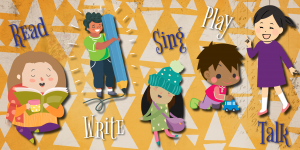
No hay nada más divertido que cantar y bailar con tu niño o tu niña. Cuando cantan juntos, apoyan una experiencia divertida durante el aprendizaje y al mismo tiempo crean un vínculo emocional entre padre e hijo.
Las investigaciones sobre el desarrollo del lenguaje indican que cuando los niños cantan desarrollan la memoria junto con su sentido rítmico. Esto les ayuda a mejorar la comprensión y la producción del lenguaje y les ayudará cuando comiencen a leer.
Puedes incluir canciones durante la rutina antes de acostarse. Esto promociona la ampliación de su vocabulario y tranquiliza a los niños a la hora de dormir.
Incorpora canciones bilingües para ayudar a tu niño a aumentar su vocabulario en dos idiomas. Enséñale a tu niño sobre la cultura con las canciones de tu infancia cantando en el idioma que tú te sientas más cómodo. Al cantar en el idioma que tú prefieres estas compartiendo tu cultura con tus hijos y al mismo tiempo desarrollando un vínculo más estrecho con ellos.
A tu niño o niña le da igual si cantas bien o mal, lo que importa es que tú estás cantando con ellos. Usa tu voz como una manera de expresar tu amor.
Bebés
Cantarle a tu bebé ayuda a tranquilizarlo y a relajarlo. Puedes cantar una canción de cuna en el idioma que tú prefieras para arrullar a tu bebé. A través de esto estimulas el desarrollo del lenguaje de tu bebé durante sus primeros años y fortaleces la conexión con tu hijo. Al cantar también enriqueces el concepto espacial del bebé al proporcionarle una actividad en la que experimenta el movimiento de su cuerpo en el espacio. Cantarle a tu bebé le enseña a tranquilizarse y a relajarse solo.
Niños de 18 a 36 meses
Puedes crear más oportunidades para exponer a los niños a la música en varios idiomas y de varias culturas—especialmente en el idioma que tú te sientes más cómodo. El ritmo ayuda a que los niños aprendan palabras y frases nuevas más fácilmente hasta en un idioma que no usan regularmente. Incluye gestos con las manos al cantar la letra de la canción para mejorar la compresión de los niños.
Niños de edad preescolar
Usa canciones para contar un cuento. Con una canción, puedes contar el cuento usando títeres. Deja que los niños actúen la historia como pantomima y que te acompañen a cantar. Incluye movimiento con tu canción—puedes bailar, saltar, girar y moverte con tu niño o niña.
-Sara, Bibliotecaria para niños, Biblioteca Valencia
Sing, Dance, And Learn!
There’s nothing more fun than singing and dancing with your child. When you sing to your child, you are providing a fun learning experience while you bond with them.
Research shows that singing builds memory by creating a strong sense of rhythm, which leads to a better ability to understand and produce language, which will help your child later on when they’re learning to read.
Add singing to your child’s bedtime routine, not only will it help build their vocabulary but singing will also help calm children and get them ready to sleep.
Add bilingual songs to your playlist and your child will get to expand their vocabulary in two different languages. Sing songs in the language you are more comfortable with that you know from your childhood, it will teach your child about their culture and help you bond together by passing on cultural traditions. It will also validate the importance of their culture and language.
Your child doesn’t care if you’re a good singer, all they care about is that you are singing to them. Use your voice as a way to express your love.
Babies
Singing helps calm and soothe babies. Sing a lullaby in the language you are comfortable with while rocking your baby. This will stimulate your child’s early language development; promote attachment, and support an infant’s growing spatial awareness as the child experiences their body moving in space. It also helps babies learn how to soothe themselves.
Toddlers
Expose children to music from different languages and cultures. Rhythm often makes it easier for children to pick up new words and phrases, even in languages that are not their own. Introduce hand gestures that accompany the lyrics to enhance children’s comprehension.
Preschoolers
Use songs as a different way to tell stories. As you sing, tell the story using puppets and have children act out and sing along with you. Add movement to your singing by dancing, jumping, twisting, and moving around with your child.
-Sara, Children’s Librarian, Valencia Library
Source
Lerner, Claire., Parlakian, Rebecca. (2016). “Beyond Twinkle, Twinkle: Using Music with Infants and Toddlers.” Zero to Three. https://www.zerotothree.org/resources/1514-beyond-twinkle-twinkle-using-music-with-infants-and-toddlers
 Read, Write, Talk, Sing, Play!
Read, Write, Talk, Sing, Play!
Singing is incredibly engaging for children and has countless early literacy benefits, which include building vocabulary, slowing down language, developing memory skills, and so much more!
Read more about early literacy and how you can make a difference in your child's life.

